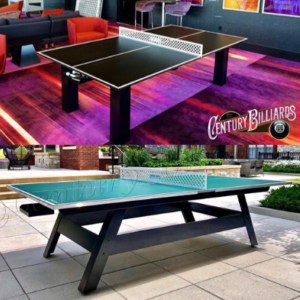What is Table Tennis?
Table tennis involves a ping pong table, which is a flat surface divided in half by a low net. Instead of the long-handled rackets of outdoor tennis, ping pong uses a short-handled paddle to smack the ball to your competitor but only after bouncing the ball on their side of the net.
Who First Invented Table Tennis?
The earliest version of the game was mentioned in Parlour Table Games by David Foster in 1890 England.The publication included table versions of popular outdoor games like lawn tennis, cricket, and football [known as soccer in America]. That version called for strung rackets, a wooden fence around a table, large side nets and a small rubber ball covered in cloth. Unlike his rules for table cricket or table football, his rules for table tennis are very limited. A copy of those rules can be found at Cambridge University.
But several people tried to adapt table tennis to a tabletop game. Tiddlywinks is actually one such attempt.
Researcher Alan Duke discovered a patent for a different tabletop adaptation of lawn tennis by Ralph Slazenger dated 1883. However, no evidence exists that the game was actually ever released or produced.
The name “Ping-Pong” was created in the late 19th century by the British game company J. Jaques and Son. Later it was trademarked by the game company Parker Brothers in the U.S.
Confusingly, John Jaques claimed in a 1901 interview in The Echo that James Devonshire invented table tennis in 1885. A patent for such a game was submitted but later marked as abandoned. No evidence of the game being produced actually exists.
Early History and Evolution of Ping Pong/Table Tennis
By 1901 tournaments were being played with as many as 300 contestants. In 1903, The Ping-Pong Association was formed in England and later changed to The United States Table Tennis Association. By 1922 rules standardized, though they vary slightly in each association.
Also, in 1902 a Japanese university professor visiting England was introduced to ping pong and loved it. He brought the game to Japan when he returned home. At the same time, British salesman Edward Shires brought it to Budapest and Vienna. The combination of both events planted the seeds for later international popularity. It especially took over Asia with notably high levels of interest in China and Japan.
During the 1900s, experimentation happened with different types of balls. Rubber balls bounced too much. Cork balls didn’t bounce enough. Eventually, a celluloid ball was created to provide the perfect bounce.
When Was The First Table Tennis Championship?
In 1922, the All England Club was created in England with many celebrities and members of the upper class playing there. The Daily Mirror organized a nationwide tournament for 40,000 contestants. In 1926, The International Table Tennis Federation (ITTF) was founded in Berlin. The first Table Tennis world championship was played in 1927 and won by Hungarian Dr. Jacobi.
Between 1926 and 1931, Mara Mednyanszky from Hungary won the World Championships five times in a row. During her career, she won 18 gold medals. In the 1950s, Angelica Rozeanu-Adelstein from Romania won the world championship six times in a row. Since then, Asian women have dominated the female singles title.
Changes to Ping Pong Paddles
In the 1950s, a sandwich or sponge rubber was created and placed on ping pong paddles. While the concept of “spin” already existed in the game, a more defensive style of play was far more common. The new style of paddles gave expert players more control over the ball. The International Tabletop Tennis Federation stepped in quickly to regulate the thickness of the rubber used in paddles to standardize its effects and prevent an unfair advantage.
Table Tennis/Ping Pong Makes Creates International Appeal
In 1957, the World Championship switched to a two-year cycle. In 1959, Rong Guotuan became the first Chinese Ping Pong champion as well as the first Chinese world champion in any international sport. Table tennis was included in the first Paralympic Games in Rome. Ironically, ping pong didn’t officially become an Olympic sport until 1988 during the games in Seoul, South Korea. The first All-Africa Championships were held in Alexandria, Egypt, in 1962.
Other Popular Names For The Game of Ping Pong
Despite the fact that the two most popular names for this game are Ping Pong and Table Tennis, the game also goes by the names:
- Gossima
- Parlour tennis
- Indoor tennis
- Whiff waff
- Pom-Pom
- Pim-Pam
- Netto
- Clip-Clap
- Royal Game
- Tennis de Salon
Late Changes to Ping Pong World Championship Rules
After the 2000 Olympics in Sydney, Australia, the official size of the ball in ping pong and table tennis was increased to 40mm. The change made to the games easier to follow on television broadcasts. The game score was switched from 21 to 11 in 2001 for the World Championships in Osaka, Japan. At those games China won for the third time, taking home all seven gold medals.
During the 2004 Olympic Games in Athens, Greece, table tennis was ranked the 5th most popular sport for television viewing. Table tennis was also part of the first Youth Olympic Games in 2010.
Is a Ping Pong Table Right For You?
Whether you call it ping pong or table tennis, this fun, indoor game is a great activity for family and friends. At Century Billiards & Game Room, we’re the experts in ping pong tables on Long Island. We have many options for indoor or outdoor ping pong tables. Visit our showroom to see them, and you can even try out a table before making a purchase. We will work with you to find the best fit for your needs and walk you through the process of customization. Fill out our contact form, schedule a consultation below, or give us a call at (631) 462-6655 to get started.



